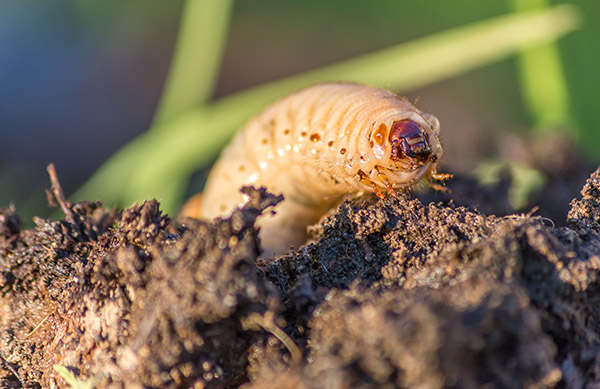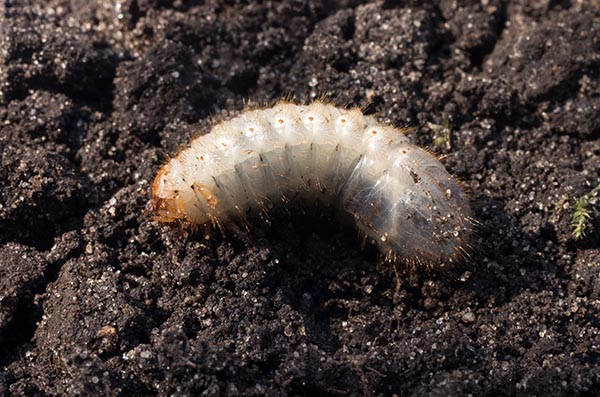
Colorado’s Grubs

Do you have a grub infestation?
If you are wondering what is going on with your lawn, it’s looking terrible with patches of dead turf, consider grub infestation. A non-professional can quickly identify grub damage in a lawn. The easiest way is to go to the damaged area of the lawn and pull some grass. If when you pull on the grass blades where the turf is still green, the turf will pull up like a fresh roll of sod. Reason being is that grubs eat the roots of the grass within one inch of the soil.
Once it is apparent that you have grub damage sift through the top inch of the sod until you find a White Grub. If you have found grubs in the soil you can conclude that the damage was caused by white grubs. In the event you cannot find a grub then the lawn may be suffering from a different problem. Possible cause can be like drought stress or spider mite damage.
This is not the only obstacle we are up against when we crave a lush green lawn in Colorado. White grubs from the Japanese beetle wreak damage on a lawn during the months of September and October. The white grubs feed on grass roots, which results in large yellowing dead or brown spots in the turf.
Beetles lay their eggs in July
Adult beetles lay their eggs in lawns during the month of July and they will only lay their eggs in lawns that wet from watering. In Colorado, July has always been a very hot and dry month. This is the time that most lawns would dry up and turn brown during the egg laying season. With continuous irrigation lawns are staying wet, even during hot and dry months like July.
Until we have major a major drought with watering restrictions, we expect to see more grub problems affecting lawns in Colorado every year. Keep a close eye on your lawn to ensure that you are grub free. If you do spot eggs or grubs, feel free to contact us for an inspection.
White Grubs or Japanese Beetle Grubs
A white grub is the immature larval form of a scarab beetle, such as a European chafer or Japanese beetle. Grubs live in the soil, feeding on plant roots. Damage caused by grubs may not be noticeable until after severe lawn damage becomes obvious.
White grubs are becoming a major problem for lawns in Colorado, due to irrigation. They feed on grass roots, which results in dead brown spots in the turf. Because of extensive root damage the turf can be peeled up from the surface almost as if it was a freshly laid piece of sod.
Many lawns have a few white grubs in them, but suffer no visible damage. When white grub population is high, large areas of turf can be lost. If you are seeing activity of foraging skunks and raccoons on your grass it is an indication of white grub infestation. These animals can dig up large sections of lawn overnight searching for their favorite food.
Can you control them?
If you notice some white grub damage in your lawn you can possibly control them by allowing the soil to dry out in the month of July. Since this is the month they lay eggs, grubs will only lay eggs in moist or wet soil. The soil should be allowed to dry out between watering. This is the only way to control them without chemical treatments, and it’s possible for the lawn to recover. Insect parasitic nematodes are a biological control option for both white grubs and billbugs.
When lawn damage becomes severe and visible to the homeowner, the grubs have become too large and this makes it more difficult to kill them. We have a treatment that is effective in controlling larger white grubs and will be happy to discuss this with you. Click here to contact us today.

Grub Life Cycle
May through early July
The Japanese beetle adults emerge from the ground and begin a search for food and to mate. The adult Japanese beetles have the ability to fly as far as one mile. Along the way they will feed on a multitude of plants. Favorites include roses, grapes, and linden trees. The younger scarab beetles may go unnoticed at this time because they are not attacking ornamental plants.
As temperatures cool down
Lawn grubs dig deeper into the soil. The white grubs will spend winter below the frost line in the soil.
July
The female beetles spend 2–3 weeks each laying up to 60 eggs in the soil. A large part of their choice depends on soil moisture and temperature. The lawn grub eggs hatch after about 2 weeks. During most of August white grubs are very small and feed on grass roots.
Spring, late April or early May
Lawn grubs move up to feed on grass roots for a short time. The lawn damage seen in the spring is often a result of fall feeding, not spring feeding.
August through October
White grubs molt into a second and then a third stage larvae, this depends on the temperature. As they grow the grubs consume grass roots rapidly. Typically late August through October is when lawn grub damage becomes most noticeable.
Late Spring
White grubs stop feeding and turn into pupae. They are resistant to chemical insecticides at this stage. Late June or early July, beetles emerge from the pupae and crawl out of the soil. This completes their life cycle.
May through early July
The Japanese beetle adults emerge from the ground and begin a search for food and to mate. The adult Japanese beetles have the ability to fly as far as one mile. Along the way they will feed on a multitude of plants. Favorites include roses, grapes, and linden trees. The younger scarab beetles may go unnoticed at this time because they are not attacking ornamental plants.
July
The female beetles spend 2–3 weeks each laying up to 60 eggs in the soil. A large part of their choice depends on soil moisture and temperature. The lawn grub eggs hatch after about 2 weeks. During most of August white grubs are very small and feed on grass roots.
August through October
White grubs molt into a second and then a third stage larvae, this depends on the temperature. As they grow the grubs consume grass roots rapidly. Typically late August through October is when lawn grub damage becomes most noticeable.
As temperatures cool down
Lawn grubs dig deeper into the soil. The white grubs will spend winter below the frost line in the soil.
Spring, late April or early May
Lawn grubs move up to feed on grass roots for a short time. The lawn damage seen in the spring is often a result of fall feeding, not spring feeding.
Late Spring
White grubs stop feeding and turn into pupae. They are resistant to chemical insecticides at this stage. Late June or early July, beetles emerge from the pupae and crawl out of the soil. This completes their life cycle.
